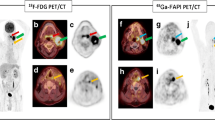Abstract
Background
Information about the normal [F-18]2-fluoro-2-deoxyglucose (FDG) uptake in the adenoids and palatine tonsils in children is not available.
Objective
The purpose of this study was to report the range of standardized uptake values (SUVs) in the normal adenoids and palatine tonsils in children, assess for the degree of asymmetry between the right and left tonsils and evaluate for the correlation of SUVs between the adenoids and tonsils.
Materials and methods
Pediatric patients who had had an FDG positron emission tomography (PET)/magnetic resonance imaging (MRI) brain study in our institution from January 2018 to March 2019 were identified. Patients with a history of malignancy, adenoidectomy and/or tonsillectomy, incomplete imaging coverage of Waldeyer ring and the presence of artifact on PET/MRI were excluded. Two pediatric radiologists independently measured the mean and maximum SUVs of the right tonsil, left tonsil and the adenoids. Range, mean and standard deviation were calculated for all measurements. Ratios of SUV of the left to right tonsils and the adenoids to the tonsils were calculated. The paired t-test and Pearson’s correlation test were used for statistical analysis with a P-value <0.05 considered to be significant.
Results
Sixty-one PET/MRI brain scans were performed in our institution during the study period. After reviewing for exclusion criteria, 41 patients were included in the study (mean age: 10.1 years, range: 2–17 years; 19 boys and 22 girls). The mean SUV was 5.30±1.57 in the right tonsil, 5.25±1.53 in the left tonsil and 4.56±1.90 in the adenoids. The maximum SUV was 8.47±2.22 in the right tonsil, 8.45±2.18 in the left tonsil and 7.59±2.94 in the adenoids. The difference between the SUVs of the right and left tonsil was not statistically significant (P=0.69 for mean SUV and P=0.90 for maximum SUV). There was a statistically significant moderately positive correlation between the FDG uptake in the adenoids and the right and left tonsil for both mean and maximum SUV (r=0.36–0.41; P=0.008–0.022).
Conclusion
There is a wide variation of FDG uptake in the normal tonsils and adenoids in children. Uptake in the right and left tonsils is not significantly different. There is a moderately positive correlation between the FDG uptake in the adenoids and the tonsils.





Similar content being viewed by others
References
Gualco G, Klumb CE, Barber GN et al (2010) Pediatric lymphomas in Brazil. Clinics (Sao Paulo) 65:1267–1277
Friedberg JW, Chengazi V (2003) PET scans in the staging of lymphoma: current status. Oncologist 8:438–447
Spijkers S, Littooij AS, Humphries PD et al (2019) Imaging features of extranodal involvement in paediatric Hodgkin lymphoma. Pediatr Radiol 49:266–276
Cheson BD, Fisher RI, Barrington SF et al (2014) Recommendations for initial evaluation, staging, and response assessment of Hodgkin and non-Hodgkin lymphoma: the Lugano classification. J Clin Oncol 32:3059–3068
Lee SJ, Suh CW, Lee SI et al (2014) Clinical characteristics, pathological distribution, and prognostic factors in non-Hodgkin lymphoma of Waldeyer's ring: nationwide Korean study. Korean J Intern Med 29:352–360
Laskar S, Mohindra P, Gupta S et al (2008) Non-Hodgkin lymphoma of the Waldeyer's ring: clinicopathologic and therapeutic issues. Leuk Lymphoma 49:2263–2271
Epstein JB, Epstein JD, Le ND, Gorsky M (2001) Characteristics of oral and paraoral malignant lymphoma: a population-based review of 361 cases. Oral Surg Oral Med Oral Pathol Oral Radiol Endod 92:519–525
Chen YK, Chiang RP, Hsu CH (2007) Unusually intense FDG uptake in a hypertrophied adenoid. Clin Nucl Med 32:260–261
Feio Pdo S, Gomes CB, Nogueira AS et al (2013) Reactive tonsillar enlargement showing strong 18F-FDG uptake during the follow-up of follicular lymphoma. Head Neck Pathol 7:258–262
Wong WL, Gibson D, Sanghera B et al (2007) Evaluation of normal FDG uptake in palatine tonsil and its potential value for detecting occult head and neck cancers: a PET CT study. Nucl Med Commun 28:675–680
Ahmad Sarji S (2006) Physiological uptake in FDG PET simulating disease. Biomed Imaging Interv J 2:e59
Burrell SC, Van den Abbeele AD (2005) 2-Deoxy-2-[F-18]fluoro-D-glucose-positron emission tomography of the head and neck: an atlas of normal uptake and variants. Mol Imaging Biol 7:244–256
Birkin E, Moore KS, Huang C et al (2018) Determinants of physiological uptake of 18F-fluorodeoxyglucose in palatine tonsils. Medicine (Baltimore) 97:e11040
Chen YK, Su CT, Chi KH et al (2007) Utility of 18F-FDG PET/CT uptake patterns in Waldeyer's ring for differentiating benign from malignant lesions in lateral pharyngeal recess of nasopharynx. J Nucl Med 48:8–14
Chen YK, Wang SC, Cheng RH et al (2014) Utility of 18F-FDG uptake in various regions of Waldeyer's ring to differentiate benign from malignant lesions in the midline roof of the nasopharynx. Nucl Med Commun 35:922–931
Nave H, Gebert A, Pabst R (2001) Morphology and immunology of the human palatine tonsil. Anat Embryol (Berl) 204:367–373
Shammas A, Lim R, Charron M (2009) Pediatric FDG PET/CT: physiologic uptake, normal variants, and benign conditions. Radiographics 29:1467–1486
Viglianti BL, Wong KK, Gross MD, Wale DJ (2018) Common pitfalls in oncologic FDG PET/CT imaging. J Am Osteopath Coll Radiol 7:5–17
Afaq A, Fraioli F, Sidhu H et al (2017) Comparison of PET/MRI with PET/CT in the evaluation of disease status in lymphoma. Clin Nucl Med 42:e1–e7
Lyons K, Seghers V, Sorensen JI et al (2015) Comparison of standardized uptake values in normal structures between PET/CT and PET/MRI in a tertiary pediatric hospital: a prospective study. AJR Am J Roentgenol 205:1094–1101
Author information
Authors and Affiliations
Corresponding author
Ethics declarations
Conflicts of interest
None
Additional information
Publisher’s note
Springer Nature remains neutral with regard to jurisdictional claims in published maps and institutional affiliations.
Rights and permissions
About this article
Cite this article
Kumbhar, S.S., Qi, J. Normal FDG uptake in the adenoids and palatine tonsils in children on PET/MRI. Pediatr Radiol 50, 958–965 (2020). https://doi.org/10.1007/s00247-020-04650-z
Received:
Revised:
Accepted:
Published:
Issue Date:
DOI: https://doi.org/10.1007/s00247-020-04650-z




